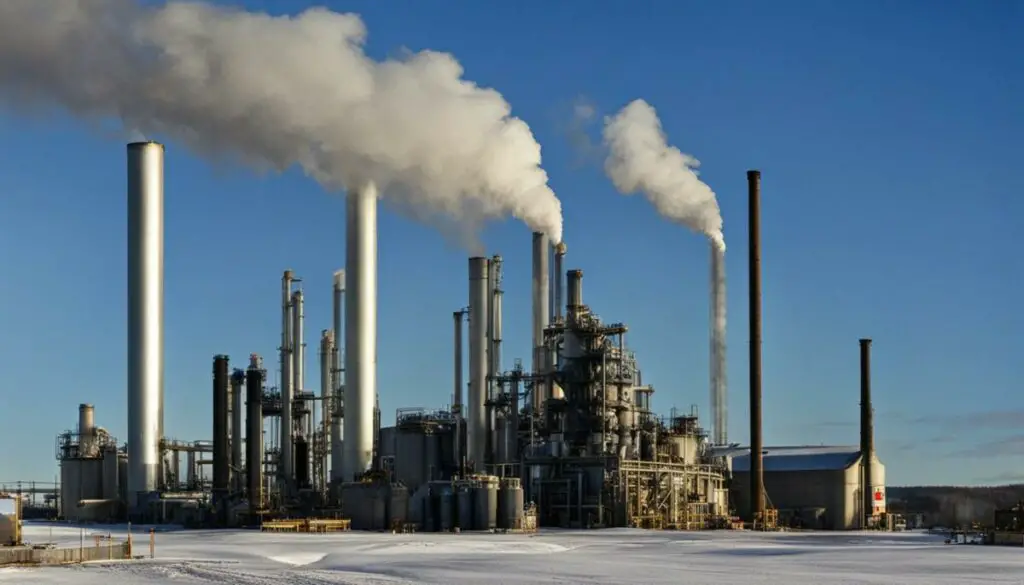Last Updated on 6 months by Francis
Greenhouse gases are known to have a significant impact on the Earth’s climate, but how exactly do they work? One of the key processes that occurs with greenhouse gases is the absorption of infrared radiation. In this section, we will explore the fundamental question of whether greenhouse gases have the ability to absorb infrared radiation and how they contribute to the greenhouse effect.
Greenhouse gases are a group of gases that trap heat within the Earth’s atmosphere, contributing to global warming and associated climate impacts. These gases include carbon dioxide, methane, nitrous oxide, and fluorinated gases.
The greenhouse gas effect occurs when these gases absorb infrared radiation that is emitted by the Earth’s surface. The gases then re-emit some of this energy back to the Earth’s surface, leading to an overall warming effect.
Understanding the process of infrared absorption by greenhouse gases is a vital step in comprehending the role that greenhouse gases play in shaping our planet’s climate and overall health.
Contents
Key Takeaways
- Greenhouse gases play a crucial role in the Earth’s climate.
- The greenhouse gas effect occurs when these gases trap heat within the Earth’s atmosphere.
- Infrared radiation is absorbed by greenhouse gases, leading to an overall warming effect.
- Understanding the process of infrared absorption is essential in comprehending the role of greenhouse gases on the planet.
- Greenhouse gases include carbon dioxide, methane, nitrous oxide, and fluorinated gases.
Understanding the Greenhouse Gas Effect

Greenhouse gases are essential for maintaining the Earth’s temperature and supporting life as we know it. These gases, such as carbon dioxide, water vapor, and methane, absorb and trap heat in the Earth’s atmosphere, creating what is known as the greenhouse gas effect.
However, human activities, such as burning fossil fuels and deforestation, have significantly increased the concentrations of greenhouse gases in the atmosphere. This has led to a warming of the planet and various climate impacts, collectively known as climate change.
Greenhouse Gas Impact on Climate
The greenhouse gas effect plays a critical role in regulating the planet’s temperature and climate patterns. Without these gases, the Earth’s temperature would be too cold to support life, and without the natural balance of greenhouse gas concentrations, the temperature would be too hot for life to exist.
However, the increased concentration of greenhouse gases, mainly due to human activities, has tipped this balance, contributing to global warming. As temperatures rise, we face a range of climate impacts, including more frequent and severe heatwaves, droughts, flooding, and extreme weather events.
Greenhouse Gas Contribution to Global Warming
The contribution of greenhouse gases to global warming is significant. Carbon dioxide, for instance, accounts for nearly 75% of the warming effect contributed by all long-lived greenhouse gases. However, other gases, such as methane and nitrous oxide, also play a vital role in trapping heat and warming the planet.
The concentration of these gases is measured in parts per million (ppm). Before the Industrial Revolution, atmospheric concentrations of CO2 were around 280 ppm. Today, these levels have risen above 400 ppm, mainly due to the burning of fossil fuels and deforestation.
| Greenhouse Gas | Concentration (ppm) | Warming Impact Relative to CO2 |
|---|---|---|
| Carbon Dioxide (CO2) | 410 | 1 |
| Methane (CH4) | 1.86 | 28 |
| Nitrous Oxide (N2O) | 0.33 | 265 |
Table: Concentration and Warming Impact of Greenhouse Gases
It is vital to understand the greenhouse gas effect and the impact of human activities on its delicate balance to address the effects of climate change and reduce our carbon footprint.
The Science Behind Infrared Absorption by Greenhouse Gases

Infrared absorption by greenhouse gases is a complex process that occurs naturally in the Earth’s atmosphere. This phenomenon is what leads to the greenhouse effect, where certain gases trap heat and contribute to overall global warming.
The process begins with the absorption of infrared radiation by greenhouse gases such as carbon dioxide (CO2), methane (CH4), and water vapor (H2O). These gases have the unique ability to absorb certain wavelengths of infrared (IR) radiation emitted by the Earth’s surface. This absorbed energy causes the gas molecules to vibrate and become excited, which generates heat and raises the temperature of the surrounding air.
However, the process does not end there. The excited gas molecules then re-emit the absorbed energy in all directions, including back towards the Earth’s surface. This is known as greenhouse gas infrared trapping. The re-emitted energy, which cannot pass through the atmosphere, again interacts with greenhouse gas molecules, causing further heating and energy absorption. This trapping effect causes the Earth’s temperature to rise, leading to changing weather patterns and other climate impacts.
This process of infrared absorption and re-emission by greenhouse gases is a natural occurrence in the Earth’s atmosphere. However, human activities have significantly increased the concentration of these gases, primarily through the burning of fossil fuels, deforestation, and industrial processes.
The increased concentration of these gases enhances their capacity to trap more infrared radiation and eventually leads to the intensification of the greenhouse effect. This phenomenon is the main driver of global warming, which has severe environmental impacts, including the rise of sea levels, more frequent extreme weather events, and biodiversity loss.
Therefore, understanding the science behind infrared absorption by greenhouse gases is essential in addressing the environmental challenges that we face today. By striving to reduce greenhouse gas emissions and finding sustainable solutions, we can ensure a healthier and safer planet for current and future generations.
The Role of Greenhouse Gases in Trapping Heat

Greenhouse gases play a crucial role in trapping heat within the Earth’s atmosphere. These gases, including carbon dioxide, methane, and water vapor, form a blanket around the planet that prevents heat from escaping back into space. Instead, the heat is absorbed, warming the Earth’s surface and leading to the greenhouse effect.
The greenhouse effect has a direct impact on the Earth’s temperature, with an increase in greenhouse gas concentrations leading to a rise in global temperatures. This phenomenon has significant implications for our planet, including changes in weather patterns, sea-level rise, and loss of biodiversity.
The ability of greenhouse gases to trap heat depends on their molecular structure and the wavelengths of radiation that they can absorb. For example, carbon dioxide molecules have a unique molecular structure that allows them to absorb long-wavelength infrared radiation, effectively trapping heat in the lower atmosphere.
Scientists have developed models to predict the impact of greenhouse gases on the Earth’s temperature, taking into account factors such as gas concentrations and atmospheric conditions. These models have shown that continued emissions of greenhouse gases will lead to further warming of the planet, highlighting the urgent need for action to mitigate these emissions.
| Greenhouse Gas | Infrared Absorption Potential |
|---|---|
| Carbon Dioxide | High |
| Methane | Very High |
| Nitrous Oxide | Very High |
As the table above illustrates, different greenhouse gases have varying abilities to absorb infrared radiation. Methane and nitrous oxide are particularly effective at trapping heat, despite their lower atmospheric concentrations.
Overall, greenhouse gases play a critical role in regulating the Earth’s temperature and climate patterns. While these gases are essential for supporting life on our planet, their continued contributions to global warming pose a significant threat to our environment. It is crucial that we take steps to reduce greenhouse gas emissions and mitigate the impact of these gases on our planet’s health.
Types of Greenhouse Gases and Their Infrared Absorption Potential

There are several types of greenhouse gases, each with its unique infrared absorption potential. Some of the most prevalent greenhouse gases include:
| Greenhouse Gas | Infrared Absorption Potential |
|---|---|
| Carbon Dioxide (CO2) | High |
| Methane (CH4) | Very High |
| Nitrous Oxide (N2O) | High |
| Fluorinated Gases (HFCs, PFCs, SF6) | Varies depending on the gas |
Carbon dioxide is the most well-known greenhouse gas and is responsible for most of the greenhouse effect. However, other gases like methane and nitrous oxide are much more effective at trapping heat and contribute significantly to global warming.
In addition to the gases listed above, water vapor is also a greenhouse gas that plays a significant role in the overall greenhouse effect. Its infrared absorption potential varies depending on atmospheric conditions, making it a complex factor to measure and analyze.
Understanding the infrared absorption potential of each greenhouse gas is crucial in identifying the most significant contributors to global warming and in developing effective strategies to mitigate their impact.
Factors Affecting Infrared Absorption by Greenhouse Gases
The absorption of infrared radiation by greenhouse gases is a complex process that is influenced by various factors. Understanding these factors is crucial for comprehending the greenhouse gas effect and its impact on global warming and climate change.
Atmospheric Conditions
The composition of the atmosphere, including air pressure and temperature, affects the way greenhouse gases absorb infrared radiation. For instance, water vapor is a potent greenhouse gas that contributes significantly to the greenhouse effect. However, it has a limited capacity to absorb infrared radiation in dry air. In contrast, when atmospheric humidity is high, water vapor becomes a more effective absorber of infrared radiation, intensifying the greenhouse effect and warming the atmosphere.
Gas Concentrations
The concentration of greenhouse gases in the atmosphere is another crucial factor affecting their ability to absorb infrared radiation. When the concentration levels of these gases increase, they absorb more infrared radiation, trapping more heat within the Earth’s atmosphere. The burning of fossil fuels, deforestation, and other human activities have led to an increase in greenhouse gas concentrations, intensifying their impact on the environment.
Gas Molecules Size and Shape
The shape and size of greenhouse gas molecules determine their ability to absorb infrared radiation. For instance, larger molecules like sulfur hexafluoride (SF6) have a more significant capacity to absorb and retain the infrared radiation compared to smaller molecules like carbon dioxide. This is because larger gas molecules have more vibrational modes and can absorb a broader range of infrared frequencies.
“Understanding the various factors that affect the absorption of infrared radiation by greenhouse gases is essential for developing strategies to mitigate their impact on climate change.”
Other Variables
Other variables like atmospheric thickness and cloud cover can also influence the absorption of infrared radiation by greenhouse gases. Clouds, for instance, can reflect and absorb some of the incoming radiation, which can affect the amount of radiation absorbed by greenhouse gases in the atmosphere. Additionally, aerosols, dust, and other particles in the atmosphere can interfere with the absorption and re-emission of infrared radiation, affecting the overall greenhouse effect.
Overall, the ability of greenhouse gases to absorb infrared radiation is a complex process influenced by various factors. Understanding these factors is essential for developing effective strategies to mitigate the impact of greenhouse gases on the environment and limit the effects of global warming and climate change.
The Relationship Between Greenhouse Gases and Climate Change
The impact of greenhouse gases on the Earth’s climate cannot be overstated. The greenhouse gas effect, which is caused by the absorption of infrared radiation by these gases, has led to an increase in global temperatures and a range of other climate impacts.
According to the Intergovernmental Panel on Climate Change (IPCC), human activities have led to a significant increase in the concentration of greenhouse gases in the Earth’s atmosphere. This increase is primarily caused by the burning of fossil fuels and deforestation, which release carbon dioxide, methane, and other potent greenhouse gases into the atmosphere.
The impact of these gases on the climate system is profound. They trap heat within the Earth’s atmosphere, leading to an overall increase in temperature. This increase in temperature has a range of cascading effects, such as changes in weather patterns, rising sea levels, and the loss of biodiversity.
The Greenhouse Gas Effect and Climate Change
The greenhouse gas effect is what causes the Earth’s atmosphere to warm. When the sun’s energy reaches the Earth’s surface, some of it is absorbed and some of it is reflected back into space. Greenhouse gases trap some of the energy that is reflected back into space, preventing it from escaping into the atmosphere.
This trapped energy causes the Earth’s temperature to rise, leading to a range of climate impacts. For example, global sea levels have risen by around 8 inches since 1880, primarily due to the melting of glaciers and ice caps caused by rising temperatures.
Infrared Absorption by Greenhouse Gases and Climate Change
Greenhouse gases, such as carbon dioxide and methane, have the ability to absorb and re-emit infrared radiation. This process traps heat within the Earth’s atmosphere and contributes to global warming. The more greenhouse gases there are in the atmosphere, the more heat is trapped, leading to an overall increase in temperature.
The IPCC has stated that it is extremely likely that human activities, such as burning fossil fuels, are responsible for the increase in greenhouse gas concentrations in the Earth’s atmosphere. This increase in greenhouse gases is the primary cause of the observed warming of the Earth’s climate system.
The Environmental Impact of Greenhouse Gas Emissions

The release of greenhouse gases into the atmosphere has significant environmental implications. These gases, including carbon dioxide, methane, and nitrous oxide, contribute to the greenhouse effect, trapping heat and causing the Earth’s temperature to rise. This phenomenon has resulted in a range of climate impacts, including melting glaciers and ice caps, rising sea levels, more frequent and intense heatwaves and droughts, and changes in precipitation patterns.
The greenhouse gas effect has had a noticeable impact on the planet, with global surface temperatures having risen by 1.1°C since the pre-industrial era. This temperature increase is largely attributed to human activities such as the burning of fossil fuels, deforestation, and agricultural practices.
The consequences of this global warming are vast and far-reaching. In addition to the physical effects on the planet, there are also economic and social impacts, such as increased costs associated with extreme weather events, displacement of populations due to sea-level rise, and food and water scarcity, particularly in vulnerable regions.
The Role of Greenhouse Gases in Contributing to Global Warming
Greenhouse gases directly contribute to global warming by trapping heat within the Earth’s atmosphere. The more greenhouse gases there are in the atmosphere, the more heat is trapped, leading to a rise in global temperatures. This process is often referred to as the “enhanced greenhouse effect.”
The role of each greenhouse gas in global warming depends on several factors, including its concentration in the atmosphere, its ability to trap heat, and its lifetime in the atmosphere. For example, carbon dioxide is the most well-known greenhouse gas and has the longest atmospheric lifetime, making it a significant contributor to global warming.
The Impact of Greenhouse Gases on Climate
Greenhouse gases have a significant impact on the Earth’s climate, leading to changes in weather patterns, sea levels, and polar ice caps. Climate models suggest that continued greenhouse gas emissions will result in even more pronounced effects.
For example, the Intergovernmental Panel on Climate Change (IPCC) predicts that by the end of the century, global temperatures could rise by 3°C or more, resulting in widespread food and water scarcity, more frequent and severe natural disasters, and the displacement of millions of people.
The Urgent Need to Address Greenhouse Gas Emissions
The continued release of greenhouse gases into the atmosphere is a significant threat to the environment and to human societies. To mitigate the impact of global warming, it is necessary to reduce these emissions as quickly and significantly as possible.
This requires a multi-faceted approach, including transitioning to clean energy sources, increasing energy efficiency, improving transportation systems, and adopting sustainable agricultural practices. The urgency of this issue is reflected in the numerous international agreements and policies aimed at reducing emissions, including the Paris Agreement and the Clean Power Plan.
It is clear that the environmental impact of greenhouse gas emissions is significant and poses a major threat to the health and well-being of the planet and its inhabitants. By taking action to reduce emissions, we can help to mitigate these consequences and create a more sustainable future for all.
The Challenges of Mitigating Greenhouse Gas Emissions

Reducing greenhouse gas emissions is critical in combatting global warming and its resultant effects. The greenhouse gas contribution to global warming cannot be denied, and scientists continue to warn of the impending environmental disasters if we do not take immediate action.
Greenhouse gases, such as carbon dioxide, methane, and nitrous oxide, are primarily emitted from human activities such as transportation, energy production, and industrial processes. These gases trap heat in the Earth’s atmosphere, leading to the greenhouse gas role in trapping heat and increasing the planet’s overall temperature.
While reducing greenhouse gas emissions is a complex challenge, it is not impossible. Governments and organizations worldwide have implemented various strategies and technologies aimed at mitigating the impact of these gases on Earth’s climate.
The Importance of Renewable Energy Sources
One of the most effective ways to reduce greenhouse gas emissions is to shift towards renewable energy sources such as wind, solar, and hydro power. These sources emit little to no greenhouse gases, reducing the overall impact on the environment.
Many countries have set targets to increase their renewable energy usage, and some have even transitioned to 100% renewable energy. Alongside this, the development of new technologies, such as energy storage systems and efficient distribution grids, has made renewable energy more accessible and reliable.
Energy Efficiency and Conservation
Improving energy efficiency and conservation is another crucial aspect of mitigating greenhouse gas emissions. By reducing energy consumption, we can lessen the need for energy production and subsequently reduce greenhouse gas emissions.
This can involve simple actions such as using energy-efficient appliances, turning off electronics when not in use, and insulating buildings to reduce heating and cooling needs. Additionally, businesses can implement energy management plans to reduce energy consumption and waste.
Policy and Regulation
Government policies and regulations can play a significant role in reducing greenhouse gas emissions. Measures such as carbon pricing, emission standards, and renewable energy incentives can encourage the adoption of cleaner practices and technologies.
International agreements, such as the Paris Agreement, aim to limit global warming to well below 2 degrees Celsius and to pursue efforts to limit the temperature increase to 1.5 degrees Celsius. These agreements can serve as a framework for governments and organizations to work together towards reducing greenhouse gas emissions for a more sustainable future.
“The challenges of mitigating greenhouse gas emissions are significant, but the consequences of inaction are too great. It is crucial that we continue to work towards reducing the greenhouse gas contribution to global warming and protecting our planet for future generations.”
The Role of Greenhouse Gases in International Climate Agreements

As the impact of greenhouse gases on climate change becomes increasingly evident, international efforts to limit their emission have gained momentum. The United Nations Framework Convention on Climate Change (UNFCCC) was established in 1992 to address the rising concern over global warming and its effects on the environment and human health. Since then, several agreements and protocols have been adopted to reduce greenhouse gas emissions and mitigate their impact on the Earth’s temperature.
The most significant of these agreements is the Paris Agreement, signed in 2015 by 197 countries. Its goal is to limit the global temperature rise to less than 2 degrees Celsius above pre-industrial levels and pursue efforts to limit the increase to 1.5 degrees Celsius. To achieve this target, countries are required to submit their own nationally determined contributions (NDCs) to reduce greenhouse gas emissions, and update them every five years with even more ambitious targets.
While the Paris Agreement is a significant step towards mitigating the impact of greenhouse gases on climate change, its success ultimately depends on individual countries’ commitments to reducing their emissions. As more countries begin to prioritize renewable energy and sustainable development, we can hope for a future where greenhouse gas emissions are significantly reduced, and the Earth’s temperature is stabilized.
“We’re the first generation to feel the impact of climate change and the last generation that can do something about it” – President Barack Obama
The Importance of International Cooperation
Given the global nature of greenhouse gas emissions and their impact on the environment, international cooperation is vital to effectively address climate change. The UNFCCC provides a platform for countries to work together towards a common goal of reducing greenhouse gas emissions and mitigating climate change’s adverse effects. The agreement also emphasizes the need for developed countries to support developing countries in transitioning to a low-carbon economy, recognizing that climate change is a global issue that requires a collective effort.
Overall, the role of greenhouse gases in international climate agreements is fundamental as it recognizes the need to mitigate their impact on the Earth’s temperature and climate patterns. Through continued international cooperation and commitment to reducing greenhouse gas emissions, we can hope to create a sustainable future that benefits both the environment and human health.
Future Perspectives on Greenhouse Gases and Infrared Absorption
As we move forward, it is critical to consider the impact of greenhouse gases on our planet and explore ways to mitigate their effects. Ongoing scientific research is continually uncovering new insights into the role of greenhouse gases in trapping heat and contributing to global warming.
One area of focus is developing technologies that can reduce greenhouse gas emissions from factories, transportation, and other sources. For example, the use of electric vehicles and solar power can help to reduce our reliance on fossil fuels, which are a significant source of greenhouse gas emissions.
Another focus is exploring ways to capture and store carbon dioxide, a potent greenhouse gas, from the atmosphere. This involves developing advanced technologies that can capture carbon dioxide emissions before they are released into the air and store them safely underground.
As we continue to learn more about the science behind greenhouse gases and infrared absorption, we can better understand their role in shaping our planet’s climate. By educating ourselves and taking action to reduce greenhouse gas emissions, we can work towards a sustainable future for ourselves and future generations.
“It is not change that we should fear, but rather the fact that we remain the same.” – Unknown
Conclusion
In conclusion, the science behind greenhouse gases and their absorption of infrared radiation is a fascinating subject that has far-reaching implications for our planet’s health and future.
The Importance of Understanding the Greenhouse Gas Effect
By understanding the greenhouse gas effect, we can appreciate the role that these gases play in trapping heat and contributing to global warming. This knowledge is vital for designing effective policies to mitigate the environmental impact of greenhouse gas emissions.
Working to Reduce Greenhouse Gas Emissions
The challenges of mitigating greenhouse gas emissions are significant, but there are already numerous strategies and technologies aimed at reducing the impact of these gases on our planet’s climate. Through continued innovation and collaboration, we can work towards a more sustainable future.
International Efforts to Combat Climate Change
International climate agreements and policies demonstrate the importance of recognizing the impact of greenhouse gases on the global climate. These efforts demonstrate a collective commitment to addressing the challenges we face and working together towards a shared goal of a healthier, more sustainable planet.
Promising Solutions for the Future
Research into greenhouse gases and their absorption of infrared radiation continues to provide valuable insights into ways we can mitigate their impact. As we move forward, we can take inspiration from promising new solutions and technologies, working towards a future where we can coexist sustainably with our planet.
By continuing to explore the science behind greenhouse gases and their absorption of infrared radiation, we can gain a deeper understanding of the impact these gases have on our planet’s climate. Armed with this knowledge, we can work towards a more sustainable future for ourselves and for generations to come.
FAQ
Do greenhouse gases absorb infrared radiation?
Yes, greenhouse gases have the ability to absorb infrared radiation.
What is the greenhouse gas effect?
The greenhouse gas effect refers to the process by which certain gases in the Earth’s atmosphere trap heat and contribute to global warming.
How do greenhouse gases absorb infrared radiation?
Greenhouse gases absorb infrared radiation by capturing and re-emitting the energy, which leads to the warming of the Earth’s atmosphere.
What role do greenhouse gases play in trapping heat?
Greenhouse gases play a crucial role in trapping heat within the Earth’s atmosphere, which contributes to the overall temperature and climate patterns of the planet.
Which types of greenhouse gases have the greatest infrared absorption potential?
The types of greenhouse gases that have the greatest infrared absorption potential include carbon dioxide (CO2), methane (CH4), and water vapor (H2O).
What factors affect the infrared absorption by greenhouse gases?
The absorption of infrared radiation by greenhouse gases can be influenced by atmospheric conditions, concentrations of gases, and other variables.
How do greenhouse gases impact climate change?
Greenhouse gases contribute to climate change by absorbing infrared radiation and altering global climate patterns.
What are the environmental implications of greenhouse gas emissions?
Greenhouse gas emissions intensify the greenhouse effect, leading to increased global warming and various environmental consequences.
What are the challenges associated with mitigating greenhouse gas emissions?
Mitigating greenhouse gas emissions poses challenges, but there are various strategies and technologies aimed at reducing their impact on the Earth’s climate.
How do greenhouse gases factor into international climate agreements?
Greenhouse gases play a significant role in international climate agreements and policies, as efforts are made globally to limit emissions and combat climate change.
What are the future perspectives on greenhouse gases and infrared absorption?
Ongoing scientific research and potential solutions aim to mitigate the impact of greenhouse gases on our planet and their absorption of infrared radiation.








